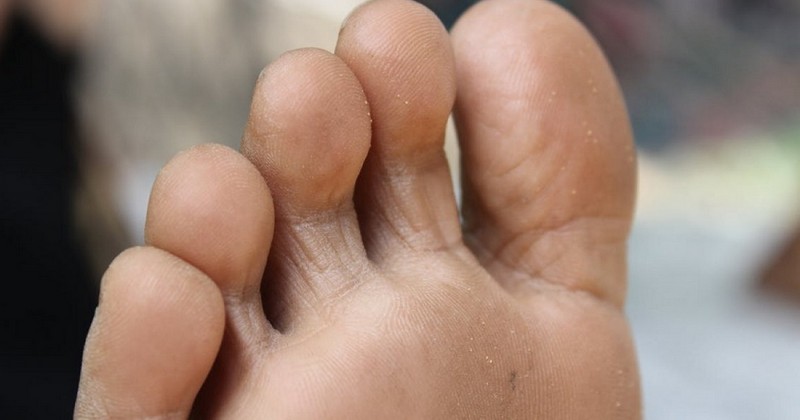Foot fungus: causes, symptoms and treatment

Infections caused by fungal invasion of skin or nails can be a problem.
Our feet are probably one of the most important parts of our daily life, and also one of the most ignored. This part of our body, in addition to being strongly innervated and connected to the rest of the body, is the base on which our body is supported to remain upright thanks to the action of our muscles. Thanks to them we can walk and move and as we do, in a bipedal way.
But this part of our anatomy can suffer from various types of problems, including unwanted visits and infection by other beings. This is the case of Fungal infection of the feet, of which we will see the main characteristics.We will see the main characteristics of this disease in this article.
Fungus in the feet
The fungal infections in the feet or presence of fungi in the feet occur when the skin or the nail of this part of our anatomy is invaded by some type of fungus. An invasion that generates an infection which in turn will cause a symptomatology that can be quite diverse depending on the species and the site of infection. These infections are produced by dermatophyte fungi, which feed on the keratin of our skin and nails..
Symptoms
When we have fungus on our feet, they settle and develop on different parts of our limb, generally between the toes, on the nails or on the sole or heel. Symptoms may vary, but in general we will find that those who suffer from foot fungus usually show the following symptoms itching and burning in the affected area, possible spots and lesions, peeling of the skin and inflammation..
The presence of a bad odor may also be indicative (although foot odor does not necessarily equate to fungus). When the affected part is the nail, there may be deformation, fragmentation or color changes (white, yellow or dark). They can also become thicker or thinner, and break or come off very easily.
Among fungal infections, the one on the feet is one of the most common, and among the most common types of fungal infection in that area we can find onychomycosis of the nails, athlete's foot (usually on the toes or between them), and (usually on the toes or between them) or paronychia (in which the infection usually occurs in the cuticle of the nail).
Causes: how are they transmitted?
Although we do not usually go barefoot in nature, the fact is that it is relatively easy to suffer from foot fungus. There are many factors that can contribute or facilitate this fact, but in general, for them to grow, a series of conditions must be present that allow the fungus to grow and expand on the skin.
One of the main and most common is our use and choice of footwear. Fungi grow easily in humid and warm areas, conditions that can be found on our feet, especially if we have them in shoes that are not very breathable and narrow. Also, a very typical way of contagion is to share hygiene material with an infected person or to go barefoot to shared areas that are usually wet, such as showers and swimming pools.
Another factor to take into account is that there are conditions that contribute to and make it easier for sufferers to develop foot fungus.. Examples of this can be found in diabetes (in which the subject should also have frequent check-ups to avoid problems such as diabetic foot), hyperhidrosis or conditions that decrease the immune system's ability to fight infections.
Linked to the above we also have to take into account that fungi are much more frequent in hot periods, and especially during the summer, this being a period in which they reproduce very easily. In addition, we must also take into account that there are professions with a higher risk of contracting them, such as athletes and professional sportsmen (the name of one of the best known infections, athlete's foot, is no mere coincidence) or those professions in which you stand for a long time.
Treatment
Fungal infections in the feet should be treated differentially depending on each case. In this sense, it is necessary to take into account possible alterations that may occur at the same time as the infection. For example, people with diabetes are more likely to have fungus and foot problems and should be more vigilant in this regard. Also If the infection also spreads down the leg, a doctor should be consulted to make sure there is nothing else going on. to verify that something more serious does not occur.
In general the treatment to be used are usually antifungal drugs and even antibiotics, often in the form of a topical cream.. Laser treatments may also be used. However, there are also oral presentations for severe cases or when the fungus occurs in the nail area. In some of the latter cases, it may even be necessary to remove the nail.
Maintaining proper hygiene in the foot area is essential for both treatment and prevention. is essential for both treatment and prevention: it is necessary to wash the feet with soap and water and rinse them properly without leaving traces of soap. The use of shoes and socks that allow perspiration will hinder infection and fungal growth. It is also necessary to avoid going barefoot in wet areas such as swimming pools or sharing hygienic items such as towels due to the ease with which the type of fungi that appear on the feet are contagious.
Bibliographic references:
- Caballero Martínez, F.; Jurado Moreno, J. and López Rocha, A. (2005). Guide of good clinical practice in fungal infections. Organización Médica Colegial de España. Ministry of Health and Consumer Affairs. Spain.
(Updated at Apr 12 / 2024)